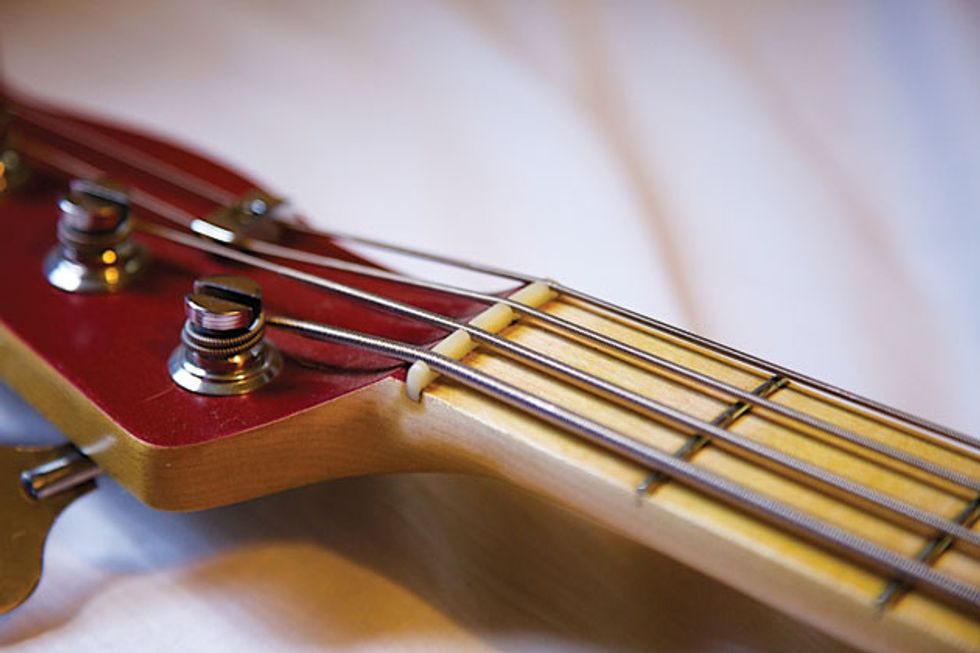
Step out of your tuning comfort zone and you may be pleased with the musical results.
Guitarists have all kinds of fun with alternate tunings. Most of my guitar-playing buddies have one guitar tuned in standard, one guitar tuned a half-step down, sometimes a guitar tuned a whole-step down, one tuned to open G, and often a guitar tuned with one of their own “secret” tunings. As bassists, we usually have a bit more conservative approach to alternate tunings.
Playing a 4-string bass exclusively from age 12 to 28 certainly left its mark on my brain. Throughout all my musical education, a 4-string bass tuned E through G was really the only way I would play—with two exceptions. My first adventure outside standard tuning occurred in my teens while playing in a heavy metal band where we all tuned every string a half-step down. We just referred to the Eb as an open E, so no additional thinking was involved.
I was enthralled with Billy Sheehan instructional videos around the same time, so I subsequently had a Hipshot Xtender detuner installed on my treasured ’58 reissue Precision. It opened up an entire new world where the octave suddenly appeared on the same fret, but two strings apart. Even though dropping the low-E string down to D while keeping the rest of the bass in standard tuning felt exciting, I also remember a feeling of comfort coming over me every time I flipped the Hipshot lever back to E.
When the gold-themed set design was announced for the tour I’m on this summer, I contacted the company that makes all my basses and asked if they had a gold instrument available. I’ve played 5-string basses almost exclusively the last 15 years, but the only one they had for me was a 4-string. I use the low-B string quite a bit in every song, so I figured I would just string the bass B through D and move all the higher melodic passages up five frets and down one string. Problem solved, right? Since I’m quite fast with transposing keys on the spot, I assumed I’d have no glitch by just playing the lowest four strings of the 5-string I’m used to. I was wrong …
I hit a few clams the first few nights. I still have to think about it when I play and I’m about 20 shows into playing with the “Low Four” bass. It turns out that when I play the highest two strings, my brain somehow gets the pitch reference by looking at the bass from the ground up, instead of from the head down (the way I get my pitch reference on the lowest two strings). I had no clue my brain worked this way until I found myself thinking that the 3rd fret of my 4th string was a Bb instead of an F, which it is on the Low Four bass.
The lesson here is that we bassists sometimes think in patterns more than actual music. Flea from Red Hot Chili Peppers says he likes to hum a bass line before picking up his bass to write one, because he doesn’t want to get stuck in his patterns. This is a fantastic technique that will help make sure you play music,not patterns.
By routing the nut a little deeper, a 4-string bass with a solid neck strung B through D can be a great alternative
to a 5-string bass.
This experience has inspired my want for a 3-string bass. (Tony Levin did this years ago.) My experience has also inspired me to want to play a 2-string bass, which was made popular by my fellow Scandinavian, Stig “Stigge” Pedersen from the Danish hard-rock band D.A.D. For many of the shows I do, I’m fairly certain I could get by with just the low B and E strings. However, playing an instrument like that and the Low Four I’m currently using requires astounding intonation. That’s because a lot of higher-register playing becomes extremely high-register playing on thicker-gauge strings, which is harder to do really in tune in the first place.
Let’s do some exercises to confuse those of you who don’t want to try fewer strings, or for those who want a challenge. First, tune your bass to D–G–D–G. Once your brain gets the layout of the top two strings, it can reapply the same patterns and principles on the 3rd and 4th strings. This is also a warm up for the next exercise: tuning your bass in fifths instead of fourths. Mandolins and violins are tuned in fifths, and tuning your bass this way completely challenges everything you know and practiced so far in standard tuning. (As an added benefit, you’ll be able to play some mandolin if you can fit your big bass fingers on the fretboard.)
To further mess with your mind, try tuning every other string a half-step down while leaving the other two strings untouched. Then flip that concept on its head and tune the two strings that were a half-step under to a half-step above their standard tuning.
These exercises aren’t designed to learn your fretboard better. They are designed to break the patterns you worked so hard to learn and make you play actual music. They’re also a great way to feel like a beginner in two seconds. And speaking from personal experience, it’s a healthy feeling. Try it!


